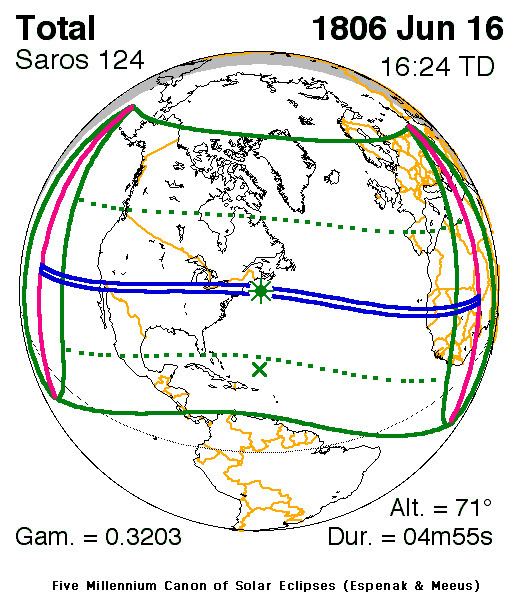Nature Total Magnitude 1.0604 Max. width of band 210 km (130 mi) Start date June 16, 1806 | Gamma 0.3204 Duration 295 sec (4 m 55 s) Greatest eclipse 16:24:27 | |
 | ||
A total solar eclipse occurred on June 16, 1806. A solar eclipse occurs when the Moon passes between Earth and the Sun, thereby totally or partly obscuring the image of the Sun for a viewer on Earth. A total solar eclipse occurs when the Moon's apparent diameter is larger than the Sun's, blocking all direct sunlight, turning day into darkness. Totality occurs in a narrow path across Earth's surface, with the partial solar eclipse visible over a surrounding region thousands of kilometres wide. Totality was visible in a diagonal path across the United States, and ended in North Africa.
Contents
Observations
It has been called Tecumseh's Eclipse after the Shawnee chief Tecumseh realized that the only hope for the various tribes in east and central North America was to join together. He was assisted by his brother-Tenskwatawa -a "prophet" who called for a rejection of the "white ways" and a return to traditional values. Tenskwatawa was ready for Tecumseh and had learned from explorers that a total Solar Eclipse was to occur. Tecumseh ordered the Great Spirit to release the sun.
José Joaquín de Ferrer observed from Kinderhook, New York and gave the name corona to the glow of the faint outer atmosphere of the Sun seen during a total eclipse; he proposes that the corona must belong to the Sun, not the Moon, because of its great size. Ferrer also states, that during the total eclipse of 1806, the irregulations of the moon's surface were plainly discernible.
Related eclipses
It is a part of solar Saros 124.
